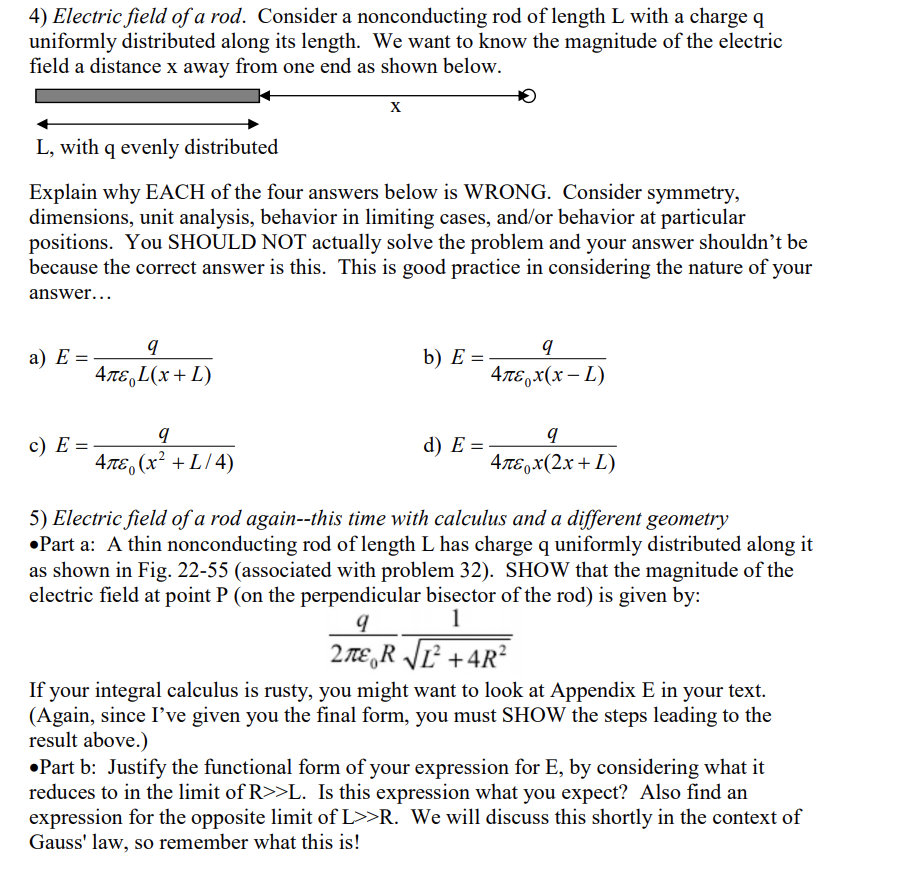4) Electric field of a rod. Consider a nonconducting rod of length L with a charge q uniformly distributed along its length. We want to know the magnitude of the electric field a distance x away from one end as shown below. L, with q evenly distributed Explain why EACH of the four answers below is WRONG. Consider symmetry, dimensions, unit analysis, behavior in limiting cases, and/or behavior at particular positions. You SHOULD NOT actually solve the problem and your answer shouldn’t be because the correct answer is this. This is good practice in considering the nature of your answer.. a) E = b) E = Απε, L (x + L) ΑπεοX(x-L) c) E = d) E = Απε, (x + LI4) 4tɛ,x(2x+ L)
4) Electric field of a rod. Consider a nonconducting rod of length L with a charge q uniformly distributed along its length. We want to know the magnitude of the electric field a distance x away from one end as shown below. L, with q evenly distributed Explain why EACH of the four answers below is WRONG. Consider symmetry, dimensions, unit analysis, behavior in limiting cases, and/or behavior at particular positions. You SHOULD NOT actually solve the problem and your answer shouldn’t be because the correct answer is this. This is good practice in considering the nature of your answer.. a) E = b) E = Απε, L (x + L) ΑπεοX(x-L) c) E = d) E = Απε, (x + LI4) 4tɛ,x(2x+ L)
Power System Analysis and Design (MindTap Course List)
6th Edition
ISBN:9781305632134
Author:J. Duncan Glover, Thomas Overbye, Mulukutla S. Sarma
Publisher:J. Duncan Glover, Thomas Overbye, Mulukutla S. Sarma
Chapter6: Power Flows
Section: Chapter Questions
Problem 6.27P
Related questions
Question

Transcribed Image Text:4) Electric field of a rod. Consider a nonconducting rod of length L with a charge q
uniformly distributed along its length. We want to know the magnitude of the electric
field a distance x away from one end as shown below.
X
L, with q evenly distributed
Explain why EACH of the four answers below is WRONG. Consider symmetry,
dimensions, unit analysis, behavior in limiting cases, and/or behavior at particular
positions. You SHOULD NOT actually solve the problem and your answer shouldn't be
because the correct answer is this. This is good practice in considering the nature of your
answer...
а) Е:
b) E =
4πε, L(x + L)
4TE,x(x – L)
c) E =
d) E =
4л, (х? + L/4)
4лєрх(2х + L)
5) Electric field of a rod again--this time with calculus and a different geometry
•Part a: A thin nonconducting rod of length L has charge q uniformly distributed along it
as shown in Fig. 22-55 (associated with problem 32). SHOW that the magnitude of the
electric field at point P (on the perpendicular bisector of the rod) is given by:
1
2 TE,R JĽ² +4R²
If your integral calculus is rusty, you might want to look at Appendix E in your text.
(Again, since I've given you the final form, you must SHOW the steps leading to the
result above.)
•Part b: Justify the functional form of your expression for E, by considering what it
reduces to in the limit of R>>L. Is this expression what you expect? Also find an
expression for the opposite limit of L>>R. We will discuss this shortly in the context of
Gauss' law, so remember what this is!
Expert Solution
This question has been solved!
Explore an expertly crafted, step-by-step solution for a thorough understanding of key concepts.
This is a popular solution!
Trending now
This is a popular solution!
Step by step
Solved in 2 steps with 3 images

Knowledge Booster
Learn more about
Need a deep-dive on the concept behind this application? Look no further. Learn more about this topic, electrical-engineering and related others by exploring similar questions and additional content below.Recommended textbooks for you

Power System Analysis and Design (MindTap Course …
Electrical Engineering
ISBN:
9781305632134
Author:
J. Duncan Glover, Thomas Overbye, Mulukutla S. Sarma
Publisher:
Cengage Learning

Power System Analysis and Design (MindTap Course …
Electrical Engineering
ISBN:
9781305632134
Author:
J. Duncan Glover, Thomas Overbye, Mulukutla S. Sarma
Publisher:
Cengage Learning